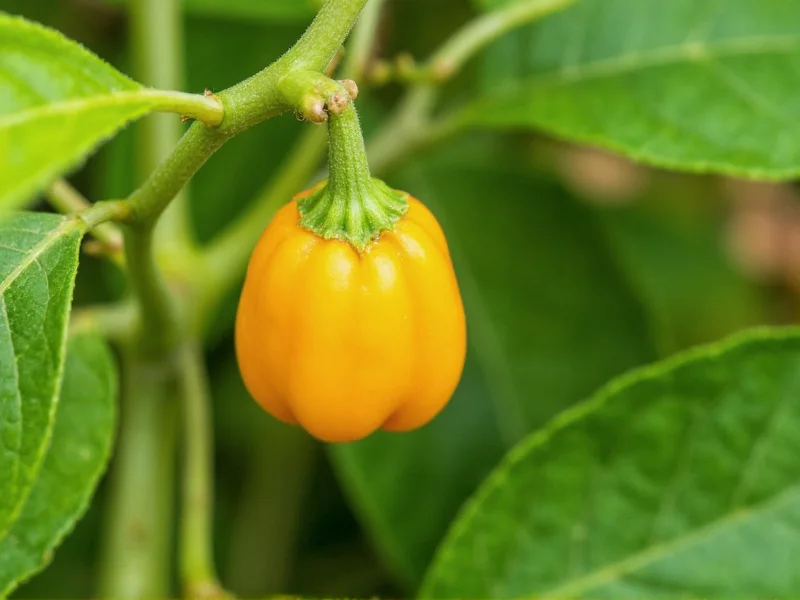Understanding whether is pepper fruit requires examining botanical science versus everyday kitchen terminology. The confusion stems from how we categorize produce differently in scientific versus culinary settings. Botanists define fruits as the mature ovary of a flowering plant, typically containing seeds. By this standard, peppers unquestionably qualify as fruits.
Botanical Definition of Fruit Explained
In botanical terms, a fruit forms from the ovary of a flowering plant after pollination. Its primary biological function is seed protection and dispersal. This scientific definition differs significantly from culinary classifications, which often categorize foods based on flavor profile and usage.
Peppers develop directly from the fertilized flower of the Capsicum plant. As the flower's ovary matures, it swells to form the familiar pepper shape we recognize, with seeds enclosed inside. This developmental process perfectly aligns with the botanical criteria for fruit classification.
Why Peppers Are Often Mistaken for Vegetables
The culinary world typically classifies foods as vegetables when they're savory, used in main dishes, and lack sweetness. Since most peppers (except sweet varieties) have low sugar content and savory flavor profiles, chefs and home cooks commonly treat them as vegetables. This practical kitchen classification has led to widespread confusion about is bell pepper a fruit or vegetable.
| Classification Type | Pepper Status | Reasoning |
|---|---|---|
| Botanical | Fruit | Develops from flower ovary and contains seeds |
| Culinary | Vegetable | Savory flavor profile, used in savory dishes |
| Nutritional | Vegetable | Grouped with vegetables in dietary guidelines |
Peppers in the Fruit Family: Scientific Perspective
Botanists place peppers in the nightshade family (Solanaceae), alongside other fruit-vegetables like tomatoes and eggplants. The Capsicum genus produces various pepper types, all sharing the same fundamental fruit structure. When examining why are peppers considered fruits, the seed-bearing nature is definitive.
Unlike true vegetables (which come from plant roots, stems, or leaves), peppers originate from the plant's reproductive structure. This biological origin is what scientifically qualifies peppers as fruits. The pepper's fleshy interior protects the seeds until they're ready for dispersal—a key fruit characteristic.
Common Misconceptions About Pepper Classification
Many people wonder are chili peppers fruits given their intense heat. The presence of capsaicin (the compound causing heat) doesn't affect botanical classification. Heat level, color, or size variations among pepper varieties don't change their fundamental status as fruits.
Another frequent question is whether all pepper types qualify as fruits. The answer is yes—whether sweet bell peppers, jalapeños, habaneros, or ghost peppers, they all develop from flowers and contain seeds. The USDA even officially classifies peppers as fruits in botanical contexts while acknowledging their culinary treatment as vegetables.
Nutritional Benefits of Peppers as Fruits
Recognizing peppers as fruits helps us appreciate their nutritional profile. Like many fruits, peppers provide significant vitamin C—bell peppers contain more vitamin C by weight than oranges. They're also rich in vitamin A, potassium, and various antioxidants.
The fruit classification explains why peppers share nutritional characteristics with other fruits. Their vibrant colors come from carotenoids and other phytochemicals common in fruits. Understanding peppers classified as fruits helps nutritionists properly categorize their health benefits.
Historical Context of Pepper Classification
The pepper classification confusion dates back centuries. When Christopher Columbus brought chili peppers to Europe, they were called "peppers" due to their spicy quality resembling black pepper (which is botanically unrelated). This naming contributed to the vegetable misconception.
In 1893, the U.S. Supreme Court case Nix v. Hedden legally classified tomatoes as vegetables for tariff purposes, establishing the precedent that culinary usage can override botanical classification in certain contexts. This decision indirectly affected how peppers and similar produce are perceived in everyday language.
Practical Implications of Pepper Classification
For gardeners, understanding that why is pepper considered a fruit affects cultivation practices. Fruit-bearing plants often have different nutrient requirements than vegetable crops. Peppers need consistent moisture during fruit development and benefit from phosphorus-rich fertilizers.
Chefs who recognize peppers as fruits can make more informed pairing decisions. The fruit classification explains why peppers complement other fruits in salsas and chutneys. This knowledge helps answer practical questions about is pepper fruit in cooking applications.











 浙公网安备
33010002000092号
浙公网安备
33010002000092号 浙B2-20120091-4
浙B2-20120091-4